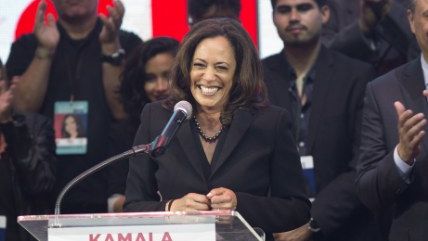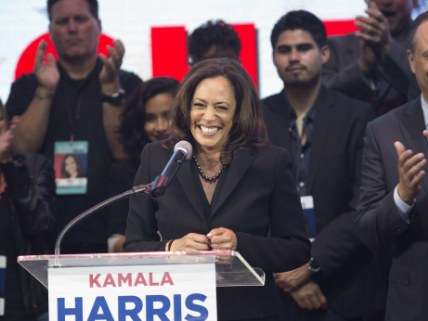More Californians Voted for Ballot Initiatives Than for a Senator
More than a million didn't bother, given the 'choice' of two Democrats.


California Attorney General Kamala Harris has easily defeated Rep. Loretta Sanchez to replace retiring Sen. Barbara Boxer. It wasn't even close: Harris is essentially getting two votes for every vote for Sanchez. She had the support of the establishment, and even President Barack Obama appeared in advertisements endorsing Harris.
Everybody mentioned above is a Democrat. There were no Republicans or Libertarians or Greens or anybody else listed as a Senate candidate for voters to consider. That's because Sanchez and Harris got the most votes in California's primary, and the state has shifted to a top-two election system for statewide and lawmaker races. Only the top-two candidates make it to the fall ballot.
Proponents of the top two system say it makes races more competitive and encourages candidates to appeal to a larger voter base. How did that work out here? Well, as can be seen above, the race was not remotely competitive. The Democratic establishment rallied behind the most powerful and connected of the two candidates and the other one was essentially left to rot.
But what about the voters? According to the latest figures from the Secretary of State's office, 8.9 million Californians cast votes for one of the candidates for president. Only 7.7 million people cast a vote for one of the senators. That's a gap of 1.2 million. That many people went through the effort to vote, but did not vote for a Senate candidate (full disclosure: I was one of them). If all those non-voters had gone for Sanchez she … still would have lost badly. But it would have been more competitive, anyway.
In fact, more people voted on most of the ballot initiatives than voted for the Senate race. 8.9 million people voted either for or against Proposition 64, the marijuana legalization initiative. More people voted on whether to ban plastic bags (8.5 million—unfortunately the ban passed) than the Senate race.
So what happens when we look at the 2010 election, when Boxer last faced a challenge (from former GOP presidential candidate Carly Fiorina)? We have to be careful with the numbers, first of all. While 100 percent of the precincts have reported in, there are still absentee and provisional ballots out there to be tabulated. These numbers are going to go up, significantly.
Still there's a noticeable difference, given that we're talking about a midterm election with no president bringing people in to vote. More than 9.8 million people cast votes in the Senate race in 2010. That's similar to the number of folks who voted in the governor's race. Similarly several ballot initiatives surpassed the 9 million vote threshold.
With so many votes still to count, the overall voter turnout may match or exceed 2010's participation. But the point here is to note the massive gap between the Senate race participation and the other major campaigns under consideration. That didn't happen in 2010, not as extensively.
If we go all the way back to 2004, where Boxer was on the ballot for another presidential election, we do see a gap between the number of votes for a presidential candidate versus another Senate candidate, but it's much smaller (about 300,000 votes). Also, overall voter turnout in 2004 was much higher than 2010, but that's not surprising given the presidential race on the ballot.
In a state like California where one political party is so dominant, this type of soft "disenfranchisement" helps protect the status quo. If voters don't know that the primary is their opportunity to get their party on the ballot, they may not bother. Recall that at the time California held its primaries, Bernie Sanders was still vying for the Democratic nomination while Donald Trump had clinched enough votes to get the GOP nod. There was a greater reason for Democrats to turn up. The end result is that the voters from one party had oversized influence on who the voters of all parties (or those who eschew party membership) get to choose from.
As a additional side note: South Dakota voters last night rejected an initiative to bring a similar top-two system (with a nonpartisan twist) to their state.
Editor's Note: As of February 29, 2024, commenting privileges on reason.com posts are limited to Reason Plus subscribers. Past commenters are grandfathered in for a temporary period. Subscribe here to preserve your ability to comment. Your Reason Plus subscription also gives you an ad-free version of reason.com, along with full access to the digital edition and archives of Reason magazine. We request that comments be civil and on-topic. We do not moderate or assume any responsibility for comments, which are owned by the readers who post them. Comments do not represent the views of reason.com or Reason Foundation. We reserve the right to delete any comment and ban commenters for any reason at any time. Comments may only be edited within 5 minutes of posting. Report abuses.
Please to post comments




Yep, that would be me. California makes ballot access in a general so fucked, my choice is Statist A or Statist B.
I was there too. voted for president and the state and local initiatives, left almost all the others blank as there is often very little choice and even where there was a D and R opposing each other, they were both pretty bad.
...the state has shifted to a top-two election system for statewide and lawmaker races. Only the top-two candidates make it to the fall ballot.
It really is a shame that California voters were stripped of the choice to vote in the general election for any of the lesser Democrats.
Proponents of the top two system say it makes races more competitive and encourages candidates to appeal to a larger voter base. How did that work out here? Well, as can be seen above, the race was not remotely competitive. The Democratic establishment rallied behind the most powerful and connected of the two candidates and the other one was essentially left to rot.
And yet I'm the asshole for being skeptical of the top-two system. I mean, an asshole for that among other things, but still...
Artificially limiting people's options creates more competition, naturally. It also gives the illusion that most people back one of the two candidates, even though a significant portion of voters only voted for one of them because they were the only ones on the ballot. Unity!
As a additional side note: South Dakota voters last night rejected an initiative to bring a similar top-two system (with a nonpartisan twist) to their state.
Our Mayoral commissar race is "non partisan".
Scott, your alt-text is second to none.
I half expected to read "would", but you surprised me yet again.
I'm in the same boat. When presented with a choice between "Communist A" and "Communist B," I choose not to vote. I bet the Soviet people had more choice when picking the Politburo.
School boards are even worse Communist A - Communist Z on the ballot, pick 3.
Did you ever find your trousers?
Unfortunately, yes. Had to wear them at work or the matriarchy will call the police. Hopefully this will change in Trump's America.
At this point, California Republicans need to start treating the "primary" as the real election. Have an informal primary or caucus before the official "primary" so that there's only one Republican candidate and the vote doesn't get so heavily diluted that the final ballot has only Democrats on it.
Third parties will continue to be well and truly fucked, though.
Note: This is not a strategy for Republicans in California to win the general election. I don't know of any such strategy. It's just to get some semblance of actual choice on the general election ballot.
That many people went through the effort to vote, but did not vote for a Senate candidate (full disclosure: I was one of them).
I was another of them. Completely disenfranchised in state offices.
It was amusing listening to long-form stories on the local NPR station that wondered why there was so little interest in the Senate race. The fact that the candidates were, in every way that matters politically, utterly indistinguishable -- due entirely to the Top Two primary -- was never mentioned.
Regardless, I still can't tell whether the supporters of Top Two are shameless, or stupid.
Same here. I voted but left that blank. It's such a sham just to ensure Dem rule forever.
Might as well go back to when the state legislatures elected the senators
I sat down with my wife and son and went over our ballots before voting. None of us voted for Senator. Not only is there no choice in Senator, but more gun control crap was passed.
Not only did that shit anti-gun prop pass, it passed by a large amount. I am going to wait until I move the hell out of this garbage state before I buy my first gun.
until I looked at the paycheck saying $4730 , I did not believe that...my... brother woz like actualy bringing in money part time from there computar. . there friend brother started doing this for less than 7 months and resently paid for the morgage on there home and bought a new Cadillac .......
........ http://www.jobprofit9.com
until I looked at the paycheck saying $4730 , I did not believe that...my... brother woz like actualy bringing in money part time from there computar. . there friend brother started doing this for less than 7 months and resently paid for the morgage on there home and bought a new Cadillac .......
........ http://www.jobprofit9.com
And now, we get to have two bay area senators! This is yet another reason to split the state.
Count me among the Sanchez voters. I had planned to no-vote this one just like I did my US House race until Harris ran out the Backpage indictments just for late-in-the-race headlines.
Same here. Same vote for the same reason.